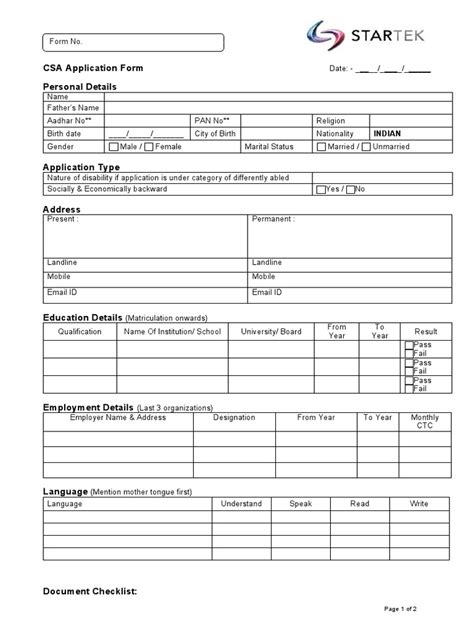Introduction

Community Supported Agriculture (CSA) programs offer a unique opportunity to connect consumers directly with local farmers, fostering sustainable food systems and promoting healthy eating habits. To participate in a CSA program, you’ll need to complete an application form. This guide provides a comprehensive overview of the CSA application process, ensuring you submit a successful application.
Step-by-Step Application Process
1. Research and Identify CSA Programs:
- Explore online directories like Local Harvest or Farm Aid to find CSA programs in your area.
- Visit local farmers’ markets or attend community events to connect with farmers and learn about their programs.
2. Determine Eligibility:
- Most CSA programs have specific eligibility requirements, such as residency in a certain area or a minimum membership duration.
- Review the program’s website or contact the farmer directly to confirm eligibility.
3. Gather Required Documents:
- Common documents required include a completed application form, proof of address, and payment information.
- Some programs may also require additional documentation, such as a copy of your driver’s license or proof of income.
4. Complete the Application Form:
- Provide accurate and complete information on the application form, including your contact details, household size, and dietary preferences.
- Carefully review the terms and conditions of the program before signing the application.
5. Submit the Application:
- Most programs accept applications online, via mail, or in person.
- Follow the specific submission instructions provided by the program.
Tips for a Successful Application
- Apply early: CSA programs often have limited membership spots, so apply early to secure your spot.
- Be thorough: Fill out the application completely and provide all required documents to avoid delays in processing.
- Communicate clearly: If you have any questions or special requests, don’t hesitate to contact the farmer directly.
- Be patient: The application process can take some time, so be patient and follow up with the farmer if you don’t hear back immediately.
Innovative Applications
Beyond traditional vegetable boxes, CSA programs are expanding their offerings to include a wider range of products and services. Here are some innovative applications to consider:
- Meat and poultry CSAs: Receive weekly or monthly deliveries of pasture-raised meats, poultry, and eggs.
- Specialty CSAs: Focus on specific products, such as fruits, flowers, honey, or dairy products.
- Farm-to-table CSAs: Offer restaurant-quality ingredients and recipes from local farmers.
- Virtual CSAs: Provide online marketplaces where consumers can connect with farmers and purchase products directly.
Benefits of CSA Membership
Participating in a CSA program offers numerous benefits, including:
- Access to fresh, local produce: Receive high-quality, seasonal produce grown without the use of harmful pesticides or chemicals.
- Support local farmers: Help sustain local farms and promote sustainable agriculture in your community.
- Connect with your food source: Learn about the farmers who grow your food and the practices they use.
- Explore new varieties: Discover different types of fruits and vegetables that you might not find in grocery stores.
- Save money: CSA memberships can be more cost-effective than buying produce from traditional grocery stores.
Comparison of CSA Programs
| Program Type | Produce | Delivery Options | Pricing |
|---|---|---|---|
| Traditional CSA | Varied assortment of vegetables | Weekly or bi-weekly | $15-$25 per week |
| Meat CSA | Pasture-raised meats, poultry, eggs | Weekly or monthly | $30-$45 per week |
| Specialty CSA | Specific products (e.g., fruits, flowers) | Varies | Varies |
| Virtual CSA | Online marketplace for farm products | Ship to home or pick up | Varies |
Frequently Asked Questions
1. What is the cost of a CSA membership?
A: Membership costs vary depending on the type of program and location, but typically range from $15-$45 per week.
2. Can I customize my CSA box?
A: Some programs offer limited customization options, while others provide a set assortment of produce.
3. What if I can’t pick up my CSA box?
A: Many programs offer alternative pick-up options or delivery services.
4. How do I cancel my CSA membership?
A: Cancellation policies vary, but most programs require notice in advance.
5. Is CSA suitable for all dietary preferences?
A: While most CSA programs cater to general dietary preferences, programs that specialize in specific products (e.g., vegan or gluten-free) are also available.
6. Are CSA programs organic?
A: Some CSA programs are certified organic, while others use sustainable farming practices that may not meet organic standards.
Conclusion
Completing a CSA application form is a crucial step towards accessing fresh, local produce and supporting local farmers. By following the step-by-step process and incorporating innovative applications, you can maximize your CSA experience and contribute to a sustainable food system in your community. Remember to apply early, be thorough, and communicate clearly to ensure a successful application.
